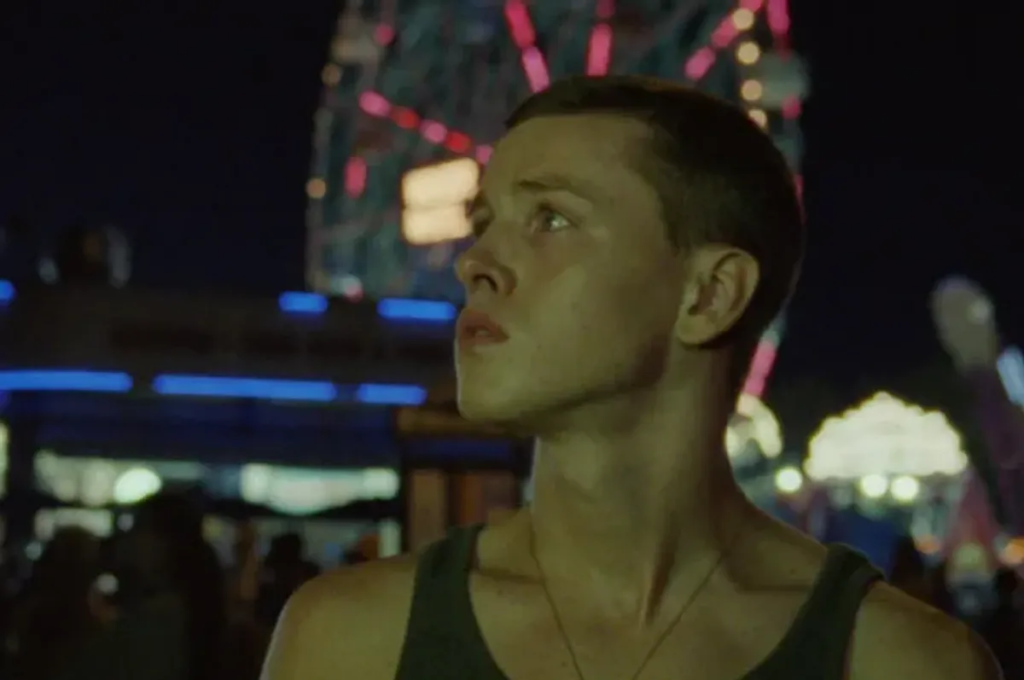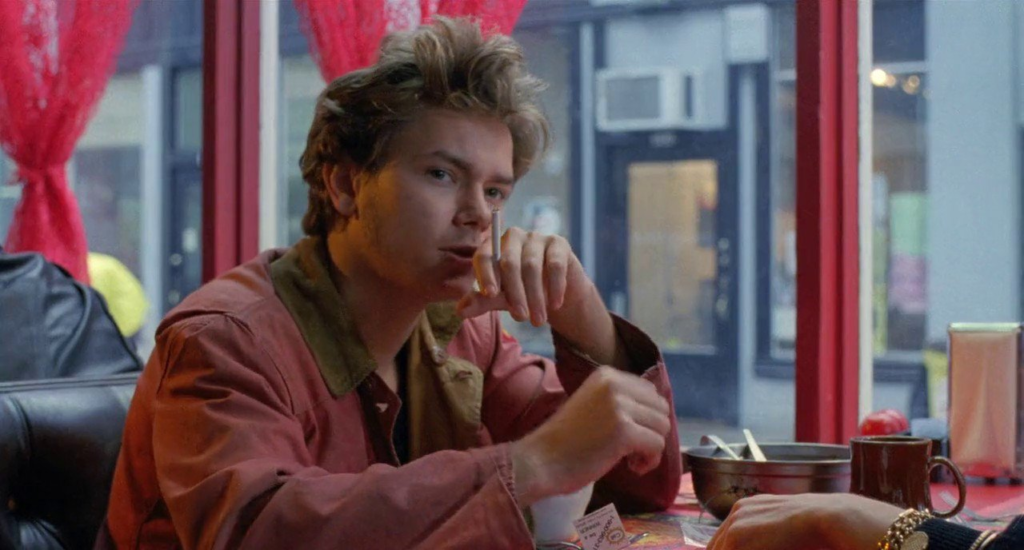Back when the cinema was male-dominated and observed, the female body was the only communication tool. Directors showcased their desires, perversion, fears, infatuation, or repulsion through the lens, the camera angle, and the shot. It always had a woman at the center of the tale and usually involved the woman whose face and body the camera –and the director- loved.
Until our female and queer directors became full-blown veterans, working their way through bigger and more solid projects, as they sank their feet into the land of filmmaking, framing the male body and face differently from how hardcore “heterosexual” male directors did. Queer and female filmmakers not only gave a more sympathetic, less aggressive inspection of the female body and sexuality, but they deconstructed traditional masculinity by making men the object of desire, flamboyance, and dissolution of the conventional power dynamics.

Those thoughts and more came to me as I watched a young Harris Dickinson unravel in Beach Rats –director Eliza Hittman’s beautiful meditation on poverty, sexuality, masculinity, coming-of-age, and existence in a small town in which time stretches forever.
Hittman accentuates Dickinson’s aesthetics for the role, perfectly encapsulating his fragility, sensitivity, lack of solid acting chops, and his visible discomfort with being watched and seen all the time. Not only was Frankie an uncomfortable young man in his skin, but so was Dickinson, hurled on himself, hiding in bed, under the covers, or even using his cap as an armor to shield his features from the world, sometimes wearing it backward just to appear cool in front of his buddies, whose company he prefers to his girlfriend, or pulling a hoodie down to cover his face as he stays in bed next to a client after sleeping with him.
Hittman uses the female (supposed) protagonist role to emphasize the mystery that is Frankie’s body and sexuality. Madeline Weinstein plays the girlfriend, Simone, with such playful flirtatious beauty. Yes, she is a small-town girl as much as Frankie, but her self-reliance and accomplishment make her bolder and more assured than him. She knows she wants him, and what she wants him to do to her. When she’s after something, she gets it. But Frankie is gay to the bone, fighting a reality that is becoming visible more and more as days go by. He’s awkward and scared, unable to comprehend what to do with his body, not just with his girlfriend but with all the male clients that he picks online. All of his sex scenes are passive. He just lies down and waits for others to make a move, and take the steps necessary to access his body. He doesn’t complain or express a specific desire, he’s just…there. That’s scary and makes Simone as frustrated as he is sometimes, unsure of what she can do with his body.

That body is Hittman’s playground. Dickinson becomes the clay she kneads for transmitting Frankie’s submissiveness and fascination with the men he meets online, his wide-eyed wonder at them exploring his body, guiding him into a dark world he’s desperately trying to become part of. Hittman perfectly blocks Dickinson, going with the camera too deep into his face, making every blemish, every freckle visible. She shows his nudity without exploiting his body, always stopping at the moment when it would become too much, and she shoots him in all awkward angles, sometimes confining him to the farthest end of the frame as if he’s in a tight chamber that is slowly closing in on him.
Dickinson’s existence there in the movie, as all those people’s sexual experiment, being caressed, kissed, held, touched, and traced, fingers clutched, grabbed, and stroked him, reminds me of another actor who has never been afraid to show flimsiness on screen, and whose beauty and sensitivity were used as a pinnacle on which an entire movie was built, River Phoenix as Mike Waters in Gus Van Sant’s My Own Private Idaho.

Van Sant is one of the most prominent faces in the New Queer Cinema wave and among the most famous contributors to the queer gaze on the screen. Seeing Nicole Kidman or Uma Thurman –two of the sexiest, most sought-after stars of the 90s- through his lens was something else, his camera beautified them, glorified them, and hinted at their femininity but it wasn’t as fetishizing as how these two stunning women were seen through the lens of other more traditionally “heteronormative” filmmakers.
So when someone as beautifully fragile, as airy and transparent as River Phoenix stands in front of Van Sant’s camera, it’s obvious how the result is breathtakingly different than anything he’s been in before. As his name describes, Phoenix is an artist who self-combusts and turns to ashes by the end of each role, then reemerges, alive and vibrant for the next. Unfortunately, his real-life sad story showed how much that burning out ate him up from the inside, that by a very young age, there was nothing left in him, but that’s for another conversation. In My Own Private Idaho, Phoenix is a fragment, a tool in the hands of the director. He compounds his openness and presence by playing a narcoleptic who suffers constant blackouts –which might grimly allude to a past of sexual abuse- and gets lost inside his head a lot of times.
The unwilling sleepiness or the blackouts, the flashbacks here and there, Van Sant uses Mike’s frail form to capture a sensation, to illustrate male vulnerability. Long shots enhance his smallness in the middle of a vast, collapsing world. Close-ups and blocking shots enhance his exposure, allowing the camera to linger on his beautiful, delicate features, especially in scenes when he’s mid-blackout, curled in on himself, carried around, hugged, touched, or even watched in fascination or awe, by his clients or the love of his life, fellow hustler Scott (Keanu Reeves). Although the film is tricky, giving us his subjective POV at times, Van Sant objectifies Mike, twisting and bending his body to become a mattress for what others choose to do with it.

While Hittman doesn’t get us inside Frankie’s thoughts in Beach Rats, Van Sant tries to show audiences the chaotic, jumbled mess that is Mike’s head. The camera cuts between extreme close-ups of parts of his face, then interjects with random nature scenes or a mythical mother figure, Van Sant gets us inside his head, maybe even his body while Hittman keeps us strictly outward, with a “body no soul” rule. While Van Sant’s hustler is more dreamy, and poetic, Hittman’s is realistic and confused, eyeing the world in wonder but never from a contemplative POV. We see the world through Frankie’s subjective lens, but we get inside Mikey, which is not always a fun place to be.
Movies like Beach Rats and My Own Private Idaho dig at unconventional male sexuality and how the discomfort arising from denying one’s truth or being haunted by the invisibility of it can lead to destructive repercussions for those young men. Mike is a less fortunate man than Frankie, but they are both sensual young men, exploited through harsh circumstances, poverty, and lack of proper guidance from an adult figure. They both grapple at whatever they can get from life, living small lives in small towns. Mike is a tumbleweed in the wind, with no roots, no origins, offering his body to strangers like a sacrificial monk. Frankie plays night games of roulette with strangers, seeking a truth he hides from everyone around him, compromising his safety and integrity, and even becoming a threat sometimes to those who seek pleasure from his youth. It’s a strange entry into the land of masculinity, deconstructed and awkwardly brought together like puzzle pieces from hell, only in the hands of acclaimed directors like Eliza Hittman and Gus Van Sant, passionate actors like the late River Phoenix and Harris Dickinson, this hell becomes a fun place to watch.





